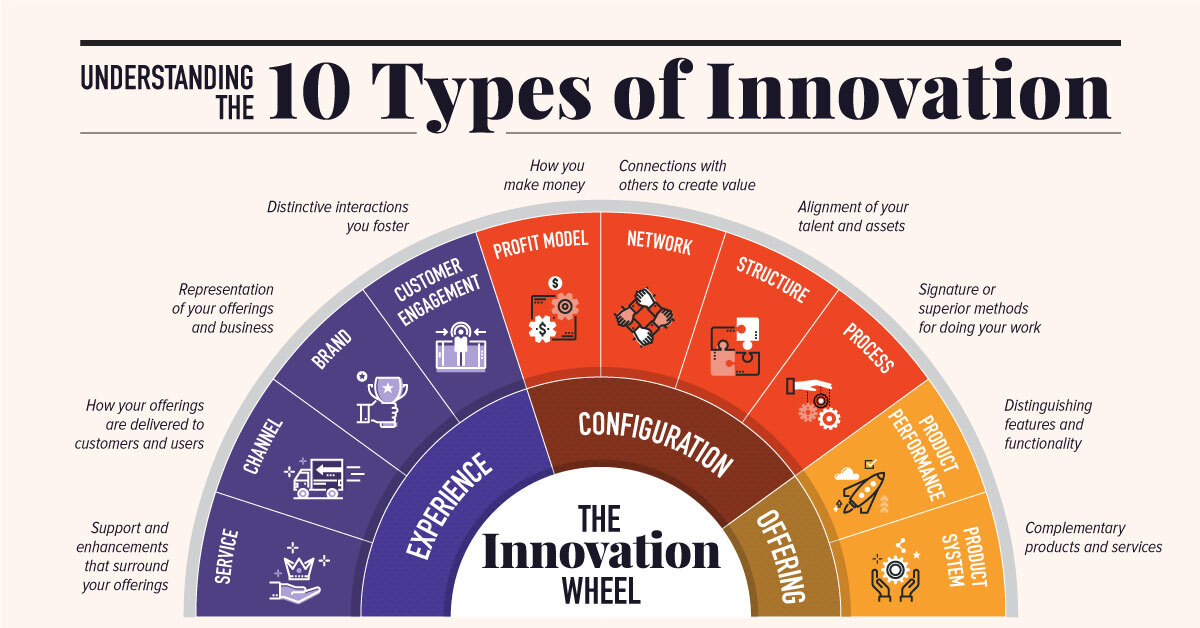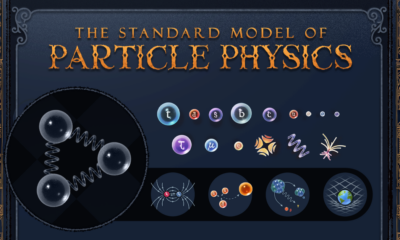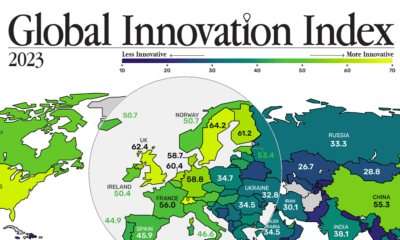Technology
10 Types of Innovation: The Art of Discovering a Breakthrough Product
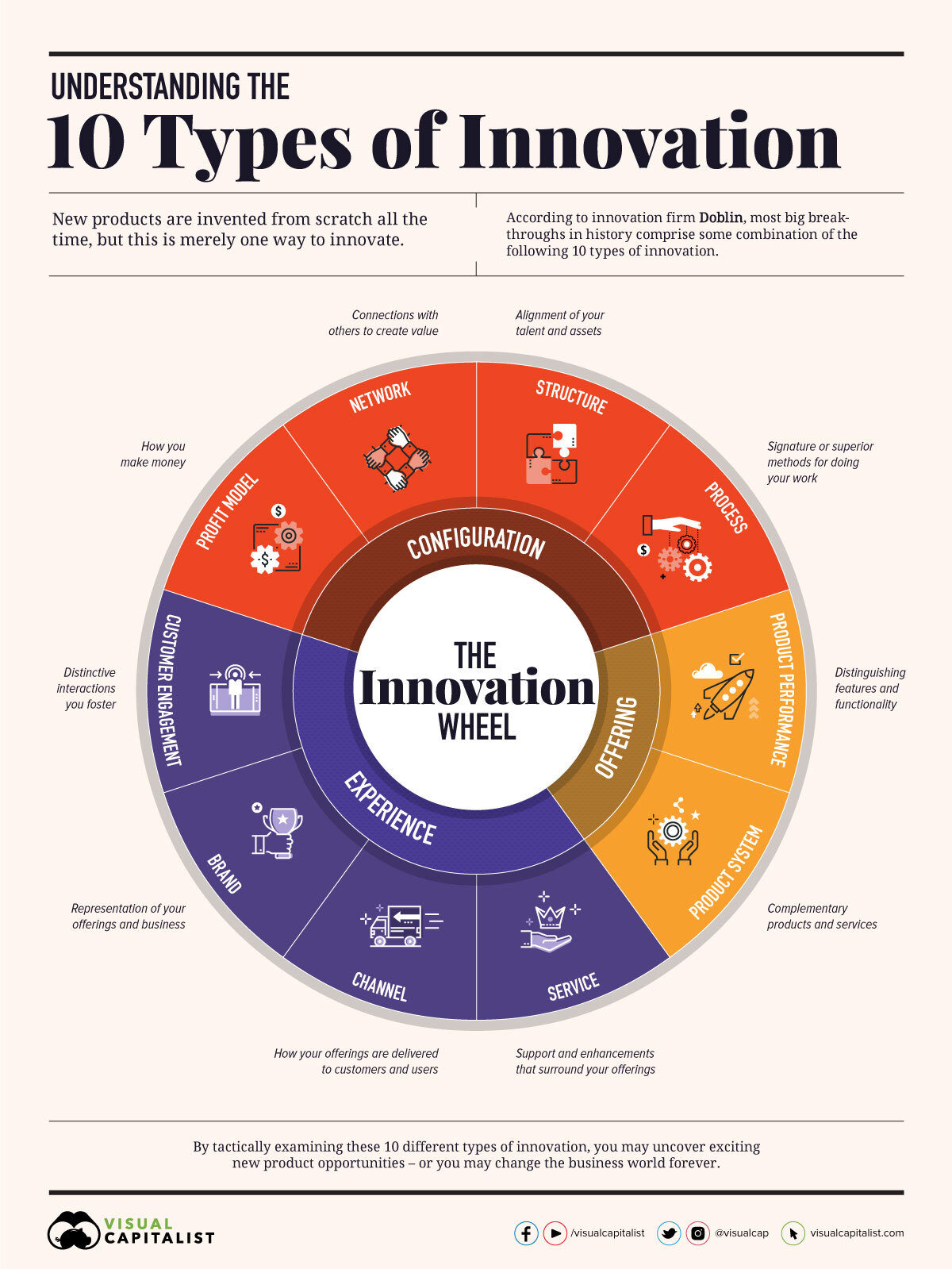
The Art of Discovering Breakthrough Products
As venture capitalist Peter Thiel once put it, “competition is for losers.”
It’s inevitable that every company must be out there battling for market share, but you don’t really want to be in a situation where the competition is so stiff that any potential upside is eroded away in the process—―a scenario known as perfect competition in economics.
To avoid perfect competition, companies must strive to build an economic moat that gives them a sustainable competitive advantage over time. While these protective moats can arise from a number of different sources, in today’s information economy they most often arise from the power of innovation.
But where does innovation come from, and is there a universal framework that can be applied to help consistently make big breakthroughs?
The 10 Types of Innovation
In today’s infographic, we showcase the culmination of years of in-depth research from Doblin, an innovation-focused firm now owned by Deloitte.
After examining over 2,000 business innovations throughout history, Doblin uncovered that most breakthroughs don’t necessarily stem from engineering inventions or rare discoveries.
Instead, they observed that innovations can be categorized within a range of 10 distinct dimensions—and anyone can use the resulting strategic framework to analyze the competition, to stress test for product weaknesses, or to find new opportunities for their products.
Here are the 10 types of innovation:
| # | Innovation Type | Description |
|---|---|---|
| 1. | Profit Model | How you make money |
| 2. | Network | Connections with others to create value |
| 3. | Structure | Alignment of your talent and assets |
| 4. | Process | Signature of superior methods for doing your work |
| 5. | Product Performance | Distinguishing features and functionality |
| 6. | Product System | Complementary products and services |
| 7. | Service | Support and enhancements that surround your offerings |
| 8. | Channel | How your offerings are delivered to customers and users |
| 9. | Brand | Representation of your offerings and business |
| 10. | Customer Engagement | Distinctive interactions you foster |
From Theory to Practice
What does innovation look like in practice?
Let’s see how well-known businesses have leveraged each of these 10 types of innovation in the past, while also diving into the tactics that modern businesses can use to consistently make new product breakthroughs:.
Innovation Types #1-4: “Configuration”
According to Doblin, the first four types of innovation center around the configuration of the company, and all the work that happens “behind the scenes”.
Although innovation types in this category are not directly customer-facing, as you can see in the examples below, they can still have an important impact on the customer experience. How your company and products are organized can have a crucial downstream effect, even enabling innovations in other categories.
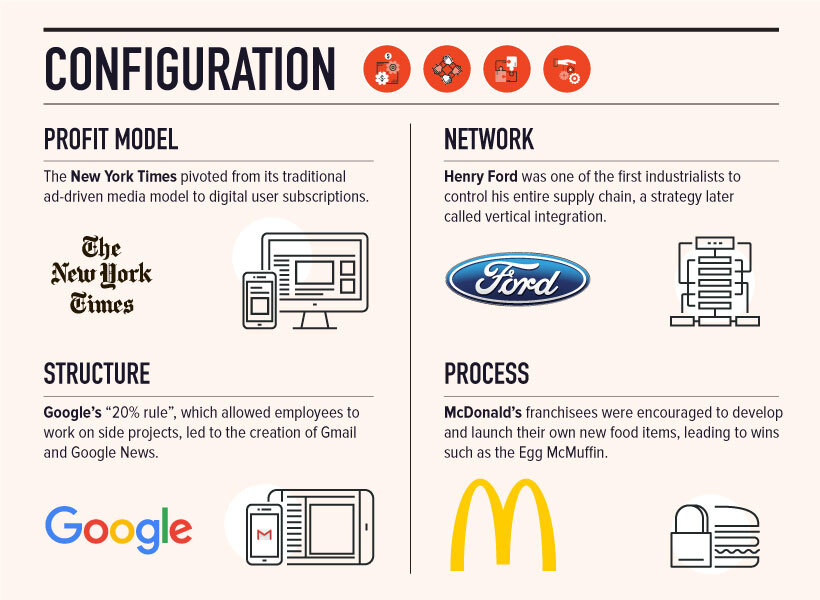
Two of the most interesting examples here are Google and McDonald’s. Both companies made internal innovations that empowered their people to make important advancements further on downstream.
In the case of McDonald’s, the franchisee insight that led to the introduction of the Egg McMuffin spearheaded the company’s entire breakfast offering, which now accounts for 25% of revenues. Breakfast is also now the company’s most profitable segment.
Innovation Types #5-6: “Offering”
When most people think of innovation, it’s likely the offering category that comes to mind.
Making improvements to product performance is an obvious but difficult type of innovation, and unless it’s accompanied by a deeply ingrained company culture towards technical innovation, such advancements may only create a temporary advantage against the competition.
This is the part of the reason that Doblin recommends that companies focus on combining multiple areas of innovation together—it creates a much more stable economic moat.
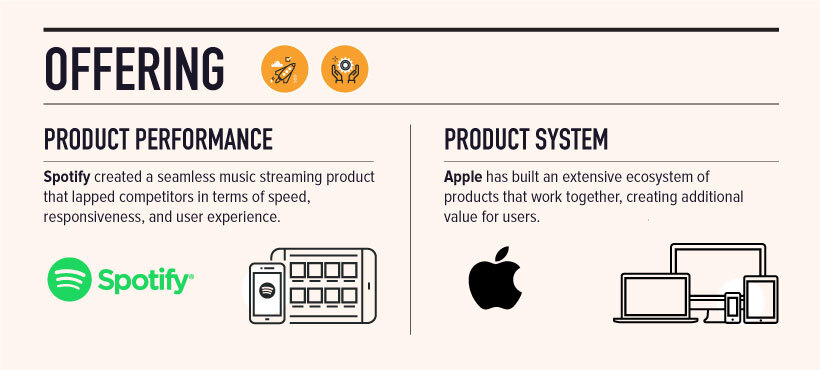
Apple has a reputation for innovation, but the product ecosystem highlighted above is an underappreciated piece of the company’s strategy. By putting thought into the ecosystem of products—and ensuring they work together flawlessly—additional utility is created, while also making it harder for customers to switch away from Apple products.
Innovation Types #7-10: “Experience”
These types of innovation are the most customer-facing, but this also makes them the most subject to interpretation.
While other innovations tend to occur upstream, innovations in experience all get trialed in the hands of customers. For this reason, intense care is needed in rolling out these ideas.
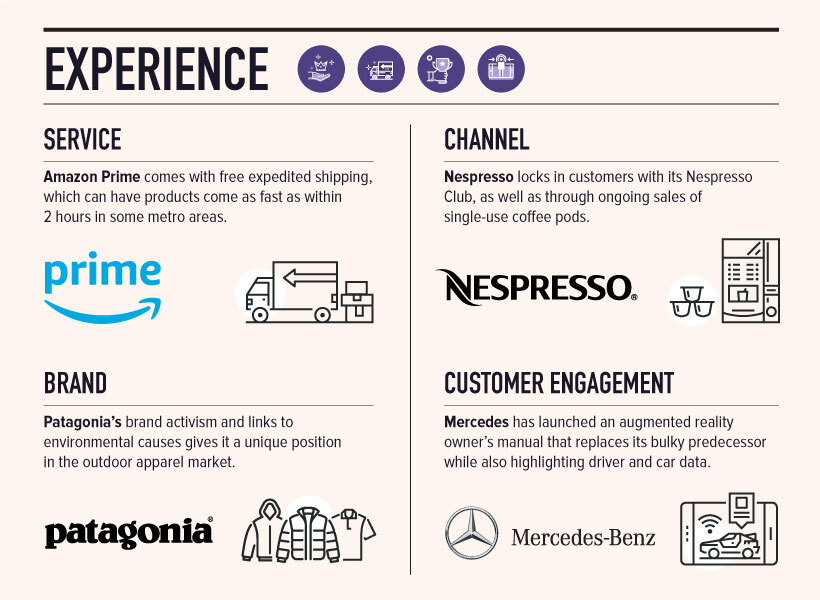
In the early days of the internet, online shipping was precarious at best—but Amazon’s introduction of Amazon Prime and free expedited shipping for all members has been a game-changer for e-commerce.
Executing on such a promise was no small task, but today there are 150 million users of Prime worldwide, including some in metro areas who can get items in as little as two hours.
Making Innovations Happen in Your Organization
How can organizations approach the 10 types of innovation from a more tactical perspective?
One useful resource is Doblin’s free public list of over 100 tactics that correspond with the aforementioned framework.
The one-pager PDF provides a range of typical dimensions for approaching each type of innovation. In essence, these are all different ways you could consider when trying to differentiate your product or service—and at the very least, it provides a useful thought experiment for managers and marketers.
For those interested in learning more on this topic, Doblin also has a highly-rated book as well as other accessories that leverage the above framework.
Technology
Charting the Next Generation of Internet
In this graphic, Visual Capitalist has partnered with MSCI to explore the potential of satellite internet as the next generation of internet innovation.

Could Tomorrow’s Internet be Streamed from Space?
In 2023, 2.6 billion people could not access the internet. Today, companies worldwide are looking to innovative technology to ensure more people are online at the speed of today’s technology.
Could satellite internet provide the solution?
In collaboration with MSCI, we embarked on a journey to explore whether tomorrow’s internet could be streamed from space.
Satellite Internet’s Potential Customer Base
Millions of people live in rural communities or mobile homes, and many spend much of their lives at sea or have no fixed abode. So, they cannot access the internet simply because the technology is unavailable.
Satellite internet gives these communities access to the internet without requiring a fixed location. Consequently, the volume of people who could get online using satellite internet is significant:
| Area | Potential Subscribers |
|---|---|
| Households Without Internet Access | 600,000,000 |
| RVs | 11,000,000 |
| Recreational Boats | 8,500,000 |
| Ships | 100,000 |
| Commercial Aircraft | 25,000 |
Advances in Satellite Technology
Satellite internet is not a new concept. However, it has only recently been that roadblocks around cost and long turnaround times have been overcome.
NASA’s space shuttle, until it was retired in 2011, was the only reusable means of transporting crew and cargo into orbit. It cost over $1.5 billion and took an average of 252 days to launch and refurbish.
In stark contrast, SpaceX’s Falcon 9 can now launch objects into orbit and maintain them at a fraction of the time and cost, less than 1% of the space shuttle’s cost.
| Average Rocket Turnaround Time | Average Launch/Refurbishment Cost | |
|---|---|---|
| Falcon 9* | 21 days | < $1,000,000 |
| Space Shuttle | 252 days | $1,500,000,000 (approximately) |
Satellites are now deployed 300 miles in low Earth orbit (LEO) rather than 22,000 miles above Earth in Geostationary Orbit (GEO), previously the typical satellite deployment altitude.
What this means for the consumer is that satellite internet streamed from LEO has a latency of 40 ms, which is an optimal internet connection. Especially when compared to the 700 ms stream latency experienced with satellite internet streamed from GEO.
What Would it Take to Build a Satellite Internet?
SpaceX, the private company that operates Starlink, currently has 4,500 satellites. However, the company believes it will require 10 times this number to provide comprehensive satellite internet coverage.
Charting the number of active satellites reveals that, despite the increasing number of active satellites, many more must be launched to create a comprehensive satellite internet.
| Year | Number of Active Satellites |
|---|---|
| 2022 | 6,905 |
| 2021 | 4,800 |
| 2020 | 3,256 |
| 2019 | 2,272 |
| 2018 | 2,027 |
| 2017 | 1,778 |
| 2016 | 1,462 |
| 2015 | 1,364 |
| 2014 | 1,262 |
| 2013 | 1,187 |
Next-Generation Internet Innovation
Innovation is at the heart of the internet’s next generation, and the MSCI Next Generation Innovation Index exposes investors to companies that can take advantage of potentially disruptive technologies like satellite internet.
You can gain exposure to companies advancing access to the internet with four indexes:
- MSCI ACWI IMI Next Generation Internet Innovation Index
- MSCI World IMI Next Generation Internet Innovation 30 Index
- MSCI China All Shares IMI Next Generation Internet Innovation Index
- MSCI China A Onshore IMI Next Generation Internet Innovation Index
MSCI thematic indexes are objective, rules-based, and regularly updated to focus on specific emerging trends that could evolve.

Click here to explore the MSCI thematic indexes

-

 Technology1 week ago
Technology1 week agoCountries With the Highest Rates of Crypto Ownership
While the U.S. is a major market for cryptocurrencies, two countries surpass it in terms of their rates of crypto ownership.
-

 Technology1 week ago
Technology1 week agoMapped: The Number of AI Startups By Country
Over the past decade, thousands of AI startups have been funded worldwide. See which countries are leading the charge in this map graphic.
-

 Technology3 weeks ago
Technology3 weeks agoAll of the Grants Given by the U.S. CHIPS Act
Intel, TSMC, and more have received billions in subsidies from the U.S. CHIPS Act in 2024.
-

 Technology3 weeks ago
Technology3 weeks agoVisualizing AI Patents by Country
See which countries have been granted the most AI patents each year, from 2012 to 2022.
-

 Technology3 weeks ago
Technology3 weeks agoHow Tech Logos Have Evolved Over Time
From complete overhauls to more subtle tweaks, these tech logos have had quite a journey. Featuring: Google, Apple, and more.
-

 AI1 month ago
AI1 month agoRanked: Semiconductor Companies by Industry Revenue Share
Nvidia is coming for Intel’s crown. Samsung is losing ground. AI is transforming the space. We break down revenue for semiconductor companies.
-

 Technology1 week ago
Technology1 week agoCountries With the Highest Rates of Crypto Ownership
-

 Mining6 days ago
Mining6 days agoVisualizing Copper Production by Country in 2023
-

 Politics7 days ago
Politics7 days agoCharted: How Americans Feel About Federal Government Agencies
-

 Healthcare1 week ago
Healthcare1 week agoWhich Countries Have the Highest Infant Mortality Rates?
-

 Demographics1 week ago
Demographics1 week agoMapped: U.S. Immigrants by Region
-

 Economy1 week ago
Economy1 week agoMapped: Southeast Asia’s GDP Per Capita, by Country
-

 Automotive1 week ago
Automotive1 week agoHow People Get Around in America, Europe, and Asia
-

 Personal Finance1 week ago
Personal Finance1 week agoVisualizing the Tax Burden of Every U.S. State

